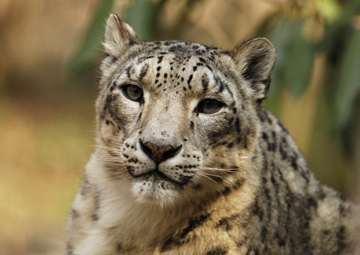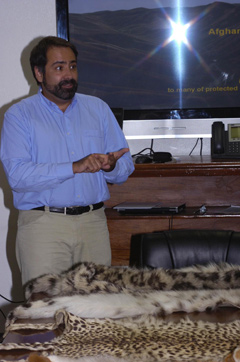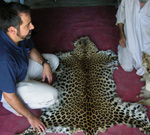U.S. military attacks illegal wildlife trade in Afghanistan
U.S. military attacks illegal wildlife trade in Afghanistan
mongabay.com
August 22, 2007
The U.S. military has teamed with the Bronx Zoo-based Wildlife Conservation Society (WCS) to attack the illegal wildlife trade in Afghanistan, according to a statement from the Department of Defense.
WCS is training military personal to recognize endangered wildlife — including snow leopards and Marco Polo sheep — that is trafficked illegally in Afghanistan’s markets. The efforts are part of a wider campaign against wildlife trade in Afghanistan, one that includes advertisements, posters in airports, educational materials for schools, and editorials and newspaper articles for the Afghan and international development community.
“The training that the Wildlife Conservation Society recently gave at Bagram Airbase for nearly all the US Customs and Military Postal Service officials in Afghanistan went extremely well,” said Dr. Alex Dehgan, head of WCS’s Afghanistan program. “The soldiers were very enthusiastic and dedicated to learning and started developing ideas among themselves to make this initiative successful. The training has immediately paid off with the seizure of illegal skins, and WCS and the EPA are now working with the military to prevent the sale of endangered species skins so soldiers won’t inadvertently lose their money due to unscrupulous merchants.”
 Snow leopard. Julie Larsen Maher/Wildlife Conservation Society |
Dehgan says that military personnel and expatriates may unknowingly purchase pelts of protected species and attempt to ship them home as souvenirs.
“I think people just don’t know,” explained Dr. Dehgan. “They don’t realize that buying one of these skins increases demand for the wildlife, and that means someone else is going to go out and hunt more of these animals.”
“I think people don’t realize the consequences,” said Clay Miller, a representative for the U.S. Environmental Protection Agency assigned to the U.S. Embassy in Kabul. “There’s a $100,000 fine if you are knowingly bringing in or shipping endangered species to the U.S.
“Many people just don’t know the U.S. laws and the trouble they can get in,” he said. “They have never been exposed to furs before and just figure, âHey I’m in Afghanistan, and (furs) are kind of cheap here.'”
 Dr. Alex Dehgan, courtesy of the Department of Defense. |
“We have an education campaign working with the Ministry of Education where we’ve been writing articles for Afghan newspapers,” Dehgan added. “We have posters that we have been putting up throughout the country in English, Dari and Pashto.”
Dehgan believes that protecting Afghanistan’s resources is key to the recovery process and will help improve stability and security, especially in areas where military intervention has fallen short and government presence is sometimes non-existent.
“Environment is security,” he told mongabay.com. “To date, it is clear that more military weapons, or training for the army alone won’t result in peace in Afghanistan. One essential part of the security equation is better management of natural resources. Habitat degradation affects both the wildlife and the people. Where 80 percent of the population is dependent on natural resources, the same actions that allow for the survival of wildlife also permit the survival of the Afghan people on this fragile landscape. When the environment fails to support the people because of environmental degradation, it may generate conflict, or exacerbate existing ones, which in turn leads to further degradation in a downward vortex towards instability.”
“We’ve had a lot of support from the Afghan people,” he added. “They actually want us to help protect their wildlife, and a lot of time they realize the plight that it’s in.”
Related
An interview with Dr. Alex Dehgan:
Adventures in conservation: protecting wildlife in Afghanistan

|
(08/07/2007) Few people associate Afghanistan with wildlife and it would come as a surprise to many that the war-torn, but fledging democracy is home to snow leopards, Persian leopards, five species of bush dog, Marco Polo Sheep, Asiatic Black Bear, Brown Bears, Striped Hyenas, and numerous bird of prey species. While much of this biodiversity has survived despite years of civil strife, Afghanistan’s wildlife faces new pressures from the very people who are charged with rebuilding the country: contractors and the development community are driving the trade in rare and endangered wildlife. This development, coupled with lack of laws regulating resource management and growing instability, complicate efforts to protect the country’s wildlife. Working to address these challenges is Dr. Alex Dehgan, Afghanistan Country Director for the Wildlife Conservation Society (WCS). WCS is working to implement the Afghanistan Biodiversity Conservation Program, a three-year project funded by the US Agency for International Development to promote wildlife and resource conservation in the country.
NOTE: This article uses quotes from two Department of Defense news releases and a previous interview that appeared on mongabay.com